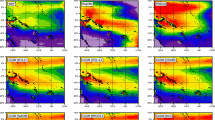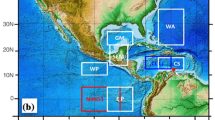Abstract
This work presents a regional climate model, the Rossby Centre regional Atmospheric model (RCA1), recently developed from the High Resolution Limited Area Model (HIRLAM). The changes in the HIRLAM parametrizations, necessary for climate-length integrations, are described. A regional Baltic Sea ocean model and a modeling system for the Nordic inland lake systems have been coupled with RCA1. The coupled system has been used to downscale 10-year time slices from two different general circulation model (GCM) simulations to provide high-resolution regional interpretation of large-scale modeling. A selection of the results from the control runs, i.e. the present-day climate simulations, are presented: large-scale free atmospheric fields, the surface temperature and precipitation results and results for the on-line simulated regional ocean and lake surface climates. The regional model modifies the surface climate description compared to the GCM simulations, but it is also substantially affected by the biases in the GCM simulations. The regional model also improves the representation of the regional ocean and the inland lakes, compared to the GCM results.
Similar content being viewed by others
Author information
Authors and Affiliations
Additional information
Received: 10 December 1999 / Accepted: 5 June 2000
Rights and permissions
About this article
Cite this article
Rummukainen, M., Räisänen, J., Bringfelt, B. et al. A regional climate model for northern Europe: model description and results from the downscaling of two GCM control simulations. Climate Dynamics 17, 339–359 (2001). https://doi.org/10.1007/s003820000109
Issue Date:
DOI: https://doi.org/10.1007/s003820000109




